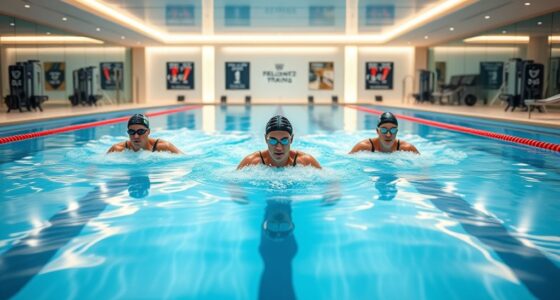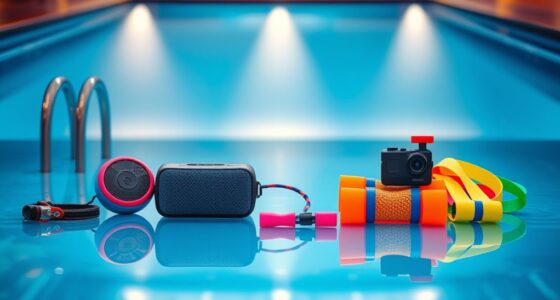To guarantee family safety around your endless pool, set clear rules like no running, diving, or swimming alone, especially for kids. Install safety rails and barriers to prevent accidental falls or unsupervised access, and regularly check their condition. Supervise children closely, keep safety equipment handy, and encourage responsible behavior. Promoting a fun, secure environment is essential—if you want practical tips on how to maximize safety with these measures, keep exploring further.
Key Takeaways
- Establish clear safety rules, including supervision, no running, and respecting pool depth markers.
- Install sturdy rails and barriers to support safe entry and prevent unsupervised access.
- Supervise children constantly and use flotation devices to enhance water safety.
- Regularly inspect safety features and upgrade technology for enhanced protection.
- Promote a safety-first mindset with consistent enforcement, accessible safety equipment, and responsible behavior.
Establishing Essential Safety Rules for Your Family
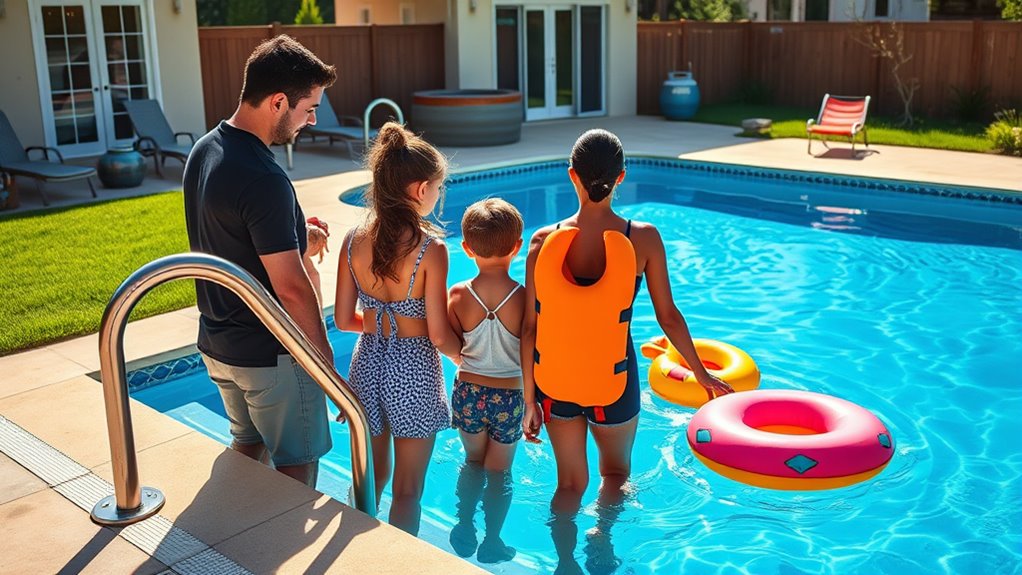
To guarantee everyone’s safety around your Endless Pool, it’s crucial to establish clear and consistent safety rules for your family. Begin by setting boundaries on when and who can use the pool. Make it mandatory for all family members to never swim alone, especially children. Emphasize the importance of no running or rough play near the pool area to prevent slips and falls. Teach everyone to always use the pool responsibly, respecting depth markers and avoiding risky behaviors. Regularly review these rules and reinforce their importance. Make certain that everyone understands that safety comes first, regardless of their swimming skills. Clear rules create a safe environment and help prevent accidents before they happen, giving you peace of mind and everyone else confidence around the pool. Additionally, incorporating safety protocols such as proper supervision and emergency preparedness can further enhance your family’s safety.
Incorporating Safety Features: Rails and Barriers
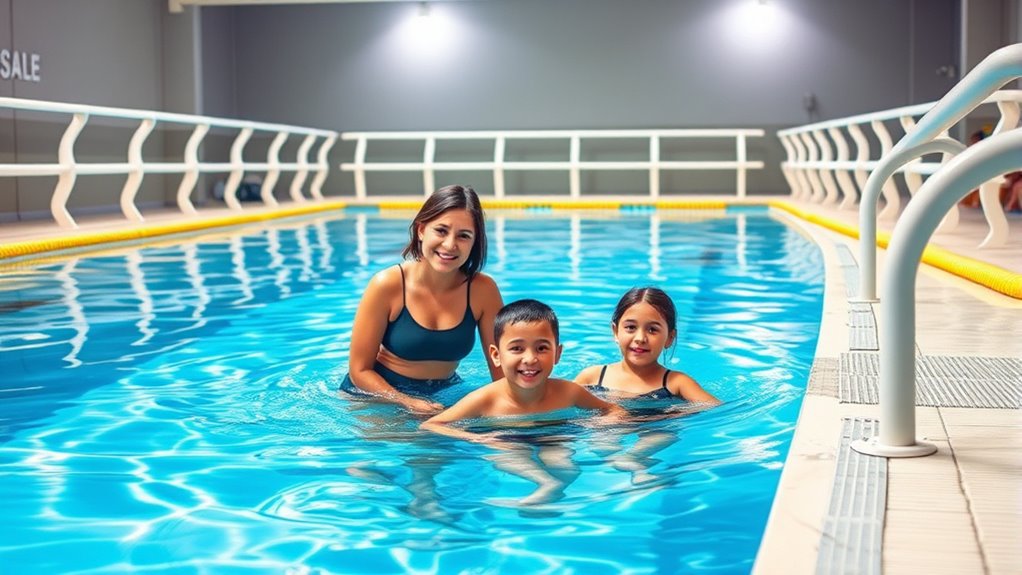
Adding safety features like rails and barriers around your Endless Pool substantially enhances protection for all users. These additions create physical boundaries that prevent accidental slips or falls, especially for children and inexperienced swimmers. Properly installed rails provide support when entering or exiting the pool, reducing the risk of injury. Barriers, such as fencing or removable covers, act as a deterrent to unsupervised access, ensuring safety when the pool isn’t in use. To maximize effectiveness, consider these key points: 1. Select durable materials that withstand weather and wear. 2. Ensure barriers are high enough to prevent climbing. 3. Install rails at ergonomic heights for easy gripping. 4. Regularly inspect and maintain safety features for maximum performance. Incorporating tuning upgrades like upgraded safety features can further improve overall pool safety and user confidence.
Practical Strategies for Safe and Enjoyable Pool Use
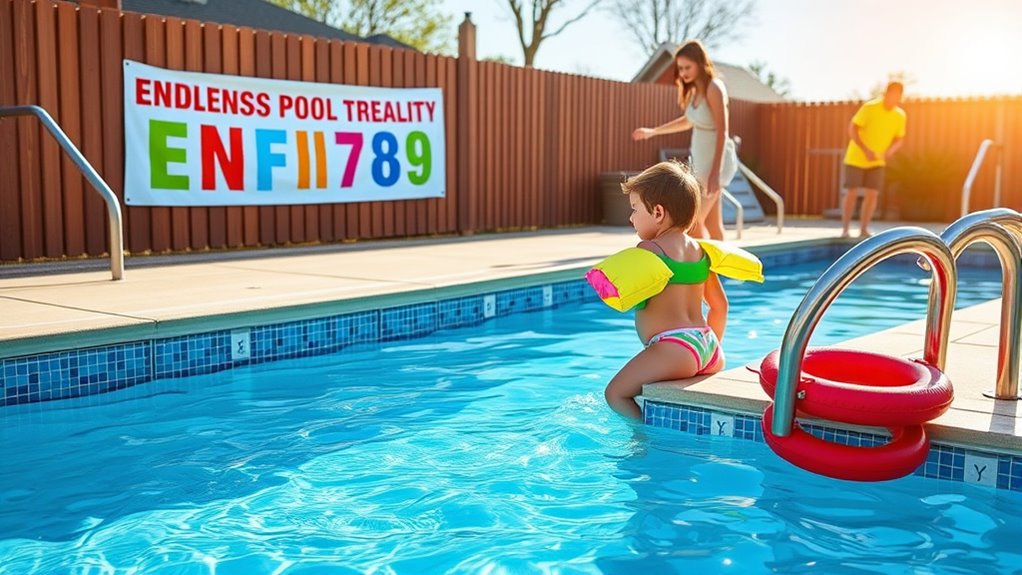
Ensuring safe and enjoyable pool use involves establishing clear rules and practicing vigilant supervision at all times. First, set simple guidelines, such as no running or diving, and make sure everyone understands them. Always supervise children directly, avoiding distractions like phones or conversations. Use designated safety zones and keep the pool area tidy to prevent accidents. Encourage kids to wear appropriate flotation devices if needed, and teach them water safety skills early. Regularly inspect safety features like rails and barriers to guarantee they’re in good condition. Keep emergency equipment nearby, such as a phone or life-saving gear. Staying informed about the latest water safety technology and best practices can further enhance your pool safety measures. By staying attentive, enforcing rules consistently, and fostering a safety-first mindset, you create a fun environment where family members can enjoy the pool responsibly.
Frequently Asked Questions
How Can I Teach Children Water Safety Skills Effectively?
You can teach children water safety skills effectively by consistently supervising them and setting clear rules. Start with basic swimming lessons and practice floating, treading water, and safe entry and exit. Use fun, age-appropriate activities to reinforce skills and make learning enjoyable. Encourage open communication so they feel comfortable asking questions. Regularly review safety rules, and always stay within arm’s reach, especially in the beginning.
What Should I Do if Someone Shows Signs of Drowning?
If someone shows signs of drowning, act quickly and stay calm. Call for emergency help immediately. Reach out with a reaching object like a pole or a towel, avoiding getting in the water if possible. If you must enter the water, support their head and keep their airway above water as you pull them to safety. Once out, check for breathing and provide CPR if needed until help arrives.
Are There Specific Safety Considerations for Elderly Family Members?
You should guarantee elderly family members can easily access safety features like grab rails and non-slip surfaces. Always supervise them closely and encourage slow, deliberate movements to avoid slips or falls. Consider installing safety alarms or sensors that alert you if they enter the pool unexpectedly. Make sure they’re comfortable with the pool’s depth and always have a rescue device nearby. Regularly review safety protocols together for their peace of mind.
How Often Should Safety Equipment and Barriers Be Inspected?
You should inspect safety equipment and barriers at least once a month. Think of it as a routine check-up for your pool’s safety, just like a regular health exam. Regular inspections catch wear and tear early, preventing accidents. Check rails, covers, and alarms carefully, ensuring everything’s secure and functioning properly. By staying vigilant and consistent, you’ll keep your family safe and enjoy peace of mind all year round.
Can I Use the Pool During Bad Weather Safely?
It’s safest not to use your pool during bad weather, especially thunderstorms, high winds, or heavy rain. Lightning poses a serious risk, so wait until the weather clears completely before swimming again. Strong winds and rain can also create dangerous conditions, like slippery surfaces or reduced visibility. Always stay alert to weather updates, and prioritize safety by avoiding pool use until conditions improve.
Conclusion
By setting clear rules, installing safety rails, and following practical tips, you create a safe oasis where your family can enjoy the pool without worry. Think of safety features as a sturdy lighthouse guiding everyone home safely through the waters. With your vigilance and these simple steps, your endless pool becomes a haven of fun and security—a place where memories are made, not marred by preventable accidents. plunge in confidently, knowing safety is your guiding star.




